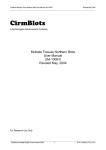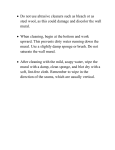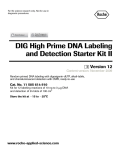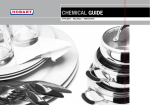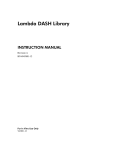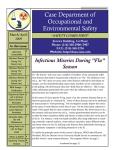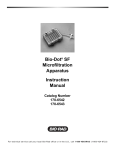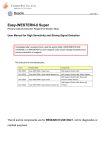Download User Manual UM1008-1
Transcript
CirmBlots Multiple Tissue Northern Blots User Manual UM-1008-1 Revised Jan. 2004 _________________________________________________________________________________________________________ CirmBlots A Technologies Advancement Company Multiple Tissues Northern Blots User Manual UM-1008-1 Revised Jan. 2004 For Research Use Only _________________________________________________________________________________________________________ CirmBlots Pre-Made Multiple Tissue Northern Blots 1 WW.CIRMBLOTS.COM CirmBlots Multiple Tissue Northern Blots User Manual UM-1008-1 Revised Jan. 2004 _________________________________________________________________________________________________________ Table of Contents I. II. III. IV. V. VI. Introduction List of Components Preparation of Additional Solutions Required CirmBlots Blots Orientation; Lanes Identification Hybridization of CirmBlots Blots Protocol VII. Trouble Shooting Guide Page 3 4 5 6 7 8 9 _________________________________________________________________________________________________________ CirmBlots Pre-Made Multiple Tissue Northern Blots 2 WW.CIRMBLOTS.COM CirmBlots Multiple Tissue Northern Blots User Manual UM-1008-1 Revised Jan. 2004 _________________________________________________________________________________________________________ I. Introduction ________________________________________________________________________ CirmBlots’ Blots are ready-to-hybridize Multiple Tissue Northern Blot optimized for intact mRNA and maximum sensitivity. CirmBlots’ Blots can be used for the relative quantitative or/and specific messages, to assess gene expression across all tissues. Identifying alternative spliced transcripts and to determine the size of specific messages. CirmBlots’ premium quality pre-made blots allow the user to precede a rapid gene expression analysis without the time consuming inconvenience of RNA isolation, gel preparation, and transfer procedures. CirmBlots’ Multiple Tissue Northern Blots contain 2-5 ug of poly A+ RNA per lane. The RNAs are carefully isolated from various human and mouse tissues. CirmBlots’ Blots are prepared by transferring gel fractionated mRNA to a positively-charged nylon membrane, which ensures the complete transfer of even long messages. We assured the transfer of the largest transcript (9 Kb). CirmBlots’ blots provide greater sensitivity than ordinary Northern Blots, CirmBlots’ Blots RNA are concentrated to a small area by using specially designed combs. A lane of marker, which sizes are 281, 725, 955, 1383, 1908, 2604, 4981 and 6583 bases is included on each CirmBlots’ blot. CirmBlots Northern Blots give maximum sensitivity and utility. They can be stripped and re-probed several times. Most of the CirmBlots contain 2-5 ug of poly A+ RNA from human or mouse tissue. CirmBlots’ Blots have been clipped in the top left-hand corner to provide an orientation for the markers and RNAs. Note diagram on the following page for RNAs orientation. To Obtain more CirmBlots Blots information and CirmBlots publications please Visit: www.cirmblots.com _________________________________________________________________________________________________________ CirmBlots Pre-Made Multiple Tissue Northern Blots 3 WW.CIRMBLOTS.COM CirmBlots Multiple Tissue Northern Blots User Manual UM-1008-1 Revised Jan. 2004 _________________________________________________________________________________________________________ II. List of Components _____________________________________________________________ Stored unused CirmBlots’ Blots at room temperature in a sealed plastic bag away from light. Store Used CirmBlots’ Blots at 4° C in a sealed plastic bag until needed. Store control probe at -20° C. z 1 CirmBlots’ Northern Blot, Premium Quality RNA z 25 ml Hybridization Solution _________________________________________________________________________________________________________ CirmBlots Pre-Made Multiple Tissue Northern Blots 4 WW.CIRMBLOTS.COM CirmBlots Multiple Tissue Northern Blots User Manual UM-1008-1 Revised Jan. 2004 _________________________________________________________________________________________________________ III. Preparation of Additional Solutions Required _____________________________________________________________ z DEPC Water z 50 mM NaOH-10 mM NaCl z 0.1 Tris-Cl (pH 7.4) z 20X SSC 3 M 0.3 M NaCl Sodium Citrate (pH 7.0) To Prepare 20X SSC Solution: 1. Dissolve 173.3 g NaCl and 88.2 g of Sodium Citrates in 800 ml of DEPC water. 2. Adjust the pH to 7.0 with a few drops of the 10NaOH solution of the concentrated Acetic Acid. 3. 4. Adjust the volume to 1 liter Auto clave z Wash Solution 1 2X SSC 0.05% SDS z Wash Solution 2 0.1X SSC 0.1% SDS _________________________________________________________________________________________________________ CirmBlots Pre-Made Multiple Tissue Northern Blots 5 WW.CIRMBLOTS.COM CirmBlots Multiple Tissue Northern Blots User Manual UM-1008-1 Revised Jan. 2004 _________________________________________________________________________________________________________ IV CirmBlots Blots Orientation; Lanes Identification _____________________________________________________________ Lanes are in the following orientation order left to right: e.g. CirmBlots item HB02: (1) Markers (2) Heart (3) Brain (4) Placenta (5) Lung (6) Liver (7) Skeletal Muscle (8) Kidney (9) Pancreas Sample RNA Lanes 1 2 3 4 5 6 7 8 Blot Numbering 9 All CirmBlots products are sold for intended for research use only unless otherwise indicated. CirmBlots products are not intended for diagnostic or drug purposes _________________________________________________________________________________________________________ CirmBlots Pre-Made Multiple Tissue Northern Blots 6 WW.CIRMBLOTS.COM CirmBlots Multiple Tissue Northern Blots User Manual UM-1008-1 Revised Jan. 2004 _________________________________________________________________________________________________________ V. A. Hybridization of CirmBlots Blots To Hybridize CirmBlots: 1. 2. 3. 4. 5. 6. Remove the CirmBlots from the sealed plastic bag. Add sufficient pre-warmed Hybridization Solution to keep the blot uniformly wet, and Prehybridize at the desired hybridization temperature. Add probe to the hybridization solution, hybridize the CirmBlots Blots at the desired hybridization temperature. Generally, we recommend the use of 1 x 106 cpm/ml of DNA or RNA probe, 1-10 pM nonisotopic DNA probe or 0.1 nM nonisotopic RNA probe. The hybridization time is typically overnight, depending on the type of hybridization buffer used, and the abundance of the target and type of probe used (RNA or DNA) Perform the post-hybridization washes. Generally the post-hybridization washes are performed at the hybridization temperature for times empirically determined to give optimal specific signal to background signal ratios. We recommend two low stringency washes of 15 minutes each and two high stringency washes of 15 minutes each. Expose the blot to X-ray film ( ³²P probe ) in a cassette. For nonisotopic detection, follow the kit or reagent manufacture’s directions. The following diagrams indicated CirmBlots RNA and Lanes locations: Sample RNA Lanes 1 2 3 4 5 6 Blot Numbering 7 8 9 Front of Northern Blot (Nucleic acid on the side) Back of Northern Blot (Nucleic acid on other side) _________________________________________________________________________________________________________ CirmBlots Pre-Made Multiple Tissue Northern Blots 7 WW.CIRMBLOTS.COM CirmBlots Multiple Tissue Northern Blots User Manual UM-1008-1 Revised Jan. 2004 _________________________________________________________________________________________________________ VI. Protocol _____________________________________________________________ I. Hybridization • Prehybridization membrane for 1-4 hours at 42 o C with 5-10 ml Prehybridization buffer. • • Heat labeled probe for 3 minutes at 95 o C, cool on ice Discard Prehybridization buffer, add hybridization buffer and probe, incubate at 42 o C at least 8 hours. • • Wash membrane 1 x 15 minutes with 2 x SSC at room temperature. Wash membrane 2 x 15 minutes with 2 x SSC with 0.1% SDS at 65 o C. • Wash membrane 1 x 15 minutes with 0.1 x SSC with 0.1% SDS at 65 o C (optional). • Wrap the membrane with saran wrap and expose film at -80 o C overnight. Note: Never let the membrane dry until the blot is stripped. If you are using hybridization bottles, make sure that the marked side of the membrane is flush against the side of the bottle. Bubbles between the membrane and the bottle can prevent hybridization to those areas. II. Stripping and Rehybridization • Wash membrane for 0.5-3 hours in strip solution at 70 - 80oC until on radioactivity can be detected on the membrane. • • The membrane can now be air dried and stored at room temperature For rehybridization several times following the hybridization protocol. _________________________________________________________________________________________________________ CirmBlots Pre-Made Multiple Tissue Northern Blots 8 WW.CIRMBLOTS.COM CirmBlots Multiple Tissue Northern Blots User Manual UM-1008-1 Revised Jan. 2004 _________________________________________________________________________________________________________ VII. Troubleshooting Guide _____________________________________________________________ A. High background Lengthening the time of low or high stringency washes rarely decreases high background signals. Remove the probe from the blot as you would for reprobing. Monitor the process with a Geiger counter to verify cpm is reduced to almost background levels. If there is still a high background, store the blot covered in plastic wrap at -20° C for 2-3 half lives. The half life of ³²P is 14 days. High background can occur for several reasons: z z z Unincorporated [ ³²P ] dNTPs are not fully removed from the probe. Check the ratio of TCA-precipitable cpm to total cpm in the final probe preparation. Adjust chromatography conditions to achieve a ratio of >95%. We also recommend purifying your hybridization probe by exclusion chromatography. Average size of the DNA probe is too large. Optimal sizes range from 200-800 nucleotides. Increase the ratio of random primers to template DNA Concentration of probe in hybridization solution is too high. 6 For DNA probes, do not exceed 2 x 10 cpm/ml. For oligonucleotide probes, do not exceed 5 x 106 cpm/ml. B. Hybridization signals absent or very weak If signals are not generated after 1-2 days of x-ray film exposure, the hybridization probe may have a low specific activity. Make a new probe with fresh ³²P. 8 The specific activity of your probe should always be >5 x 10 cpm/µg, and, for maximum sensitivity >1 x 109 cpm/µg. If specific activity is still low upon repeating the labeling, you may be using too little DNA. We use 25-50 ng measured from the OD260 of a concentrated stock. If you have a small quantity of DNA, electrophorese the amount you have been using on an agarose gel, next to a known amount of DNA markers and estimate the amount of probe DNA. If a clear ethidium bromide-stained band is not observed, you have less than 25-50 mg, and therefore, should use 2-3 times more DNA for probe labeling. If this fails, optimize labeling conditions with a known amount of control probe such as β-actin. _________________________________________________________________________________________________________ CirmBlots Pre-Made Multiple Tissue Northern Blots 9 WW.CIRMBLOTS.COM CirmBlots Multiple Tissue Northern Blots User Manual UM-1008-1 Revised Jan. 2004 _________________________________________________________________________________________________________ C. Probe not fully homologous to target If you are using a cross-species probe, you may need to reduce the stringency of your final wash by using Wash Solution 1 instead of Wash Solution 2 and decreasing the temperature by 5-10° C. When using a synthetic oligonucleotide probe, ensure that the probe is completely homologous to the target. D. Inability to strip and reprobe If you are unable to reprobe the blot, the membrane may not have been stripped completely or may have been allowed to dry or partially dry. If a membrane is allowed to even partially dry, subsequent removal of the probe may be impossible. To prevent drying after your final wash, shake off excess solution with forceps (do not blot-dry) and wrap the blot immediately with plastic wrap. When reprobing, uncover the blot, immediately place it in heated sterile water containing 0.5% SDS, and follow the rest of the protocol provided for removing probes. If the membrane has not partially dried, see Section A above. E. Signal Decreases after two reprobings This problem is especially common for low abundance genes. You may not see signals as strong as those observed for high-abundance transcripts such as β-actin. _________________________________________________________________________________________________________ CirmBlots Pre-Made Multiple Tissue Northern Blots 10 WW.CIRMBLOTS.COM










